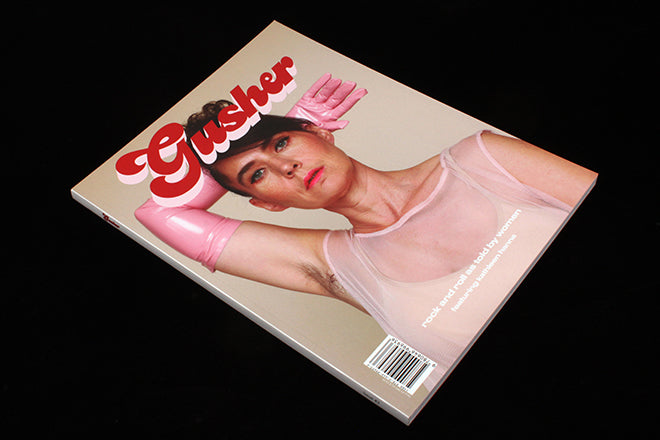
Gusher #3
Rock. And. Roll. It’s in the past, right? Not in Gusher, an annual music magazine from Australia. It’s about queering rock and roll, as told by women and genderqueer creatives (the full spectrum isn’t quite so catchy for a coverline). Gusher does it so well that we’ve chosen it as Magazine of the Week.
The Oxford English Dictionary defines the verb ‘gush’ in two ways: to speak effusively about, or (for a liquid to) flow out of something in a rapid and plentiful stream. This magazine does both: it’s effusive about the tidal wave of femme talent in rock and roll (which has always been there, by the way), and it doesn’t shy away from the feminine, nor does it seek to define or limit it.
There is no one entry point to this issue: it’s packed with so much content that focuses on the revolutionary act of making music. Whether it’s strolling through the riot grrl herstory of punk rock archivist Lisa Darms’ collection of original set lists, flyers and zines (above), or the Afro-Brazilian women using drumming to affirm their identity and culture, and empower others to stand up to the racism that they encounter on a daily basis (below).
It’s not about women, which is an important distinction. It does not ask ‘what’s it like to be a woman in music’, but rather, gets to the nitty gritty of the story, the real guts and bodily fluids of it, to fill in the gaps that the mainstream media leaves. It goes into the politics and socioeconomic background of the 1980s and 90s when The Rebel Dykes fought for acknowledgement and visiblity, (below) and acknowledges that there are many gaps in history where lesbian, black and trans voices have been erased.
Gusher takes being a woman (or non binary, queer, poc) almost for granted. In fact, it’s almost not even about music at all; these things are the hook for untold stories, experiences, talent, and knowledge. It’s written by women who are fans – of music, of other women – but it is never cloying or full of embarrassing desire, as the female fan is typically portrayed in the media.
On one of the two front covers, Kathleen Hanna, formerly of Bikini Kill and Le Tigre, looks out at the viewer, meeting our gaze, her gloved hand self-assuredly behind her head. Clothed in various shades and textures of pink, with armpit hair visible, she confronts expectations of what it means to be feminine.
That direct gaze is important in the canon of female representation in Western art history: we only have to look back to 1865 when Edouard Manet’s Olympia scandalised Paris with her shamelessness as she met the viewer’s gaze. Hanna is portrayed similarly here as the revolutionary icon that she is. The long-form feature by Phoebe Reilly reflects on her legacy in the riot grrrl movement, and sheds light on what she’s up to these days.
On the back, Hanna’s gloved hand is the star of a close up. The image is saccharine, ironically replicating high-fashion advertising, except that all the accessories are vintage or custom and you probably can’t buy them.
On the other cover, there’s something droll about Chai piling their heads on top of each other like a comic book strip – their interview’s top line is that they are out to rewrite the idea of cute (or ‘kawaii’ in their native Japanese). It’s interesting to see how defiance manifests in a band that at first glance might seem very different from the riot grrrl legacy we’re used to. Their nuanced punning and playfulness with language might be lost on a western audience but I can definitely appreciate their rejection of the term ‘girl band’ in favour of onna-band (woman-band) – a fitting rejection of the infantilising term whilst still acknowledging their womanhood.
At the moment we’re seeing a reclamation of the colour pink across many magazines, not exclusively but especially within ones that focus on women. Here, it’s not quite ‘milennial pink’, as described by The Guardian as a ‘grapefruit shade of apricotty salmon’, but it does seem to comment on an ironic attitude to prettiness, that fits with the issue’s unofficial theme of defiance.
Elsewhere in the magazine, in a piece on queer and trans musicians playing with surrealism, futurism and sci-fi in their work, Sasha Griffin makes the argument that rather than fit in, or be rejected from, cis culture; queer musicians ‘dream up worlds without history or grounding, where boundaries otherwise taken for granted can freely and joyfully dissolve.’ The typography on the openeing spread (above) is joyously non-conforming too.
In ‘The Revolution Will be Terrorised’, the ‘mother of terrorist drag’ Vaginal Davies is profiled, revealing how they came to infuse the pageantry of drag with sharp satire to confront ideas about racism, classism, sexism and homophobia. Accompanied by a selection of riotous polaroids and activist collages, the profile shines light on the dark humour and slippery subversiveness of the underground.
In a way, I think the name of the magazine itself is a reclamation of sorts. Let’s gush about music; let’s not be afraid to gush at all. In the latest magCulture Podcast we touched upon the ‘third issue syndrome’, and I think that Gusher is hitting its stride with this, their third edition, and the editorial and design choices seem as confident as the icons on the cover. Gusher is effortless in its diversity, editorial style, and design, which all helps to achieve its goal of queering rock and roll. I look forward to the next one, even if it is a year-long wait!
Editors: Isabella Trimboli and Juliette Younger
Art direction and design: Juliette Younger










